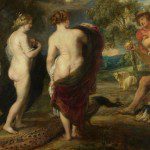Patheos Pagan feels a little altar crazy right now. I did a recent article on altars . . . . . Megan Manson at Pagan Tama wrote one . . . . and our newest writer Bekah Evie Bel put one up recently too. I promise I’m done writing about altars after this post, at least for awhile.
I find myself writing about altars again because I went “new altar” shopping with a friend over the weekend. That friend has only just begun her journey on the path of the Witch and wanted some advice (and ideas about where to shop!) on how to begin building an altar. As a twenty year veteran of the Craft I often find myself a bit jaded when I go into Metaphysical stores (I think I have almost three of everything), but being there with my friend brought a lot of the magick back. It’s fun to see things through the eyes of someone so new to it all now and again. It brings back a bit of my own early enthusiasm.
So here are some of the ideas I shared with my friend this past weekend. I hope you find them useful too.
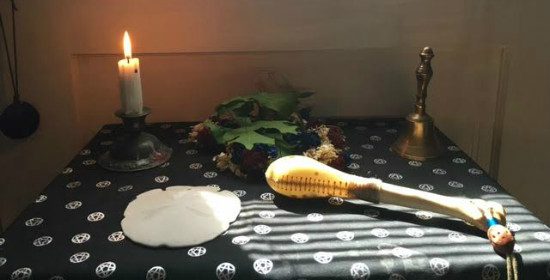
THE SIMPLE ALTAR
For someone just starting in the Craft I think a slow approach to altar building is the way to go. No one needs to run out and buy every working tool they can find right away. Those things tend to come later, I think the best way to start is with the four elements, along with an honoring of however you define the divine. For me, especially when I was just starting out, the divine were the Goddess and the God. Honoring these ideas is easy, and doesn’t even require a trip to the local Witch-store. Here are a couple of my favorite ideas.
Air: I’ve generally used incense and other smell-related things to honor Air over the years. Stick incense is extremely easy to come across (and if you don’t like messes a mostly burned-out glass pillar candle makes an excellent holder), but incense isn’t the only option here. Smudge sticks are a nice alternative, and often smell great even if you don’t light them. A flower scented oil is another great option. Away from the world of smells there are physical objects that nicely represent the element of air, I have seen lots of altars with feathers on them over the years for this very purpose. I’m also a fan of tree leaves (they fall through the air of course), but my absolute favorites are items that make clear or airy noises, like bells or a set of pan-pipes.
Fire: Most of us probably use candles to represent fire on our altars; they are cheap, magickal, and nearly an expectation in most forms of Witchcraft, but they aren’t the only option here. I like the idea of “hot” foods for fire, things like dried chili peppers or a stick of cinnamon. Speaking of sticks, a dried stick or a match is also a good representation of fire. Fire is often associated with passion, lust, and virility, so objects of a sexual nature are another choice. Certain rocks and stones directly related to fire and volcanos are another option here.
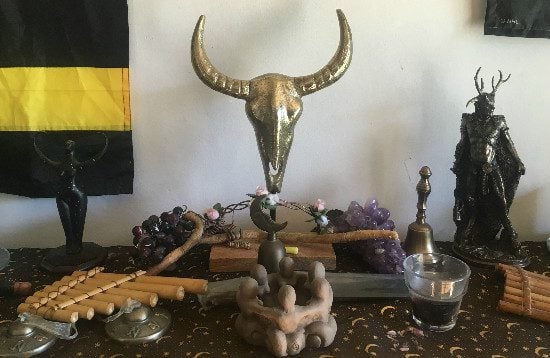
Water: My first altars were not very creative and I initially represented water on my altar in the simplest of ways: with a fancy dollar-store wine glass. This served me reasonably well for a few years, but wasn’t very durable or particularly magickal. Eventually I began representing water on my altar in other ways. An old sand-dollar I got from a boyhood vacation eventually made it’s way onto one of my altars (and is still around) and since I’m married to an Aphrodite-devotee we have numerous seashells in sacred spots. Our chalices have grown more elaborate over the years, and we also have several cauldrons and a couple of magickal looking bowls/dishes to put water in.
Earth: Rocks, crystals, salt, sand, dirt . . . . if those things represent the element of earth to you they are a solid and easy choice for the altar. (Since there are hundreds of different kinds of rocks/stones, many of them are associated with things other than the element of earth, but how many of us knew that when we were starting out? Besides, personal associations are what really matter when it comes to choosing representations of the elements.) When I think of the element earth I tend to think about things that are solid and keep me connected to the physical world; because of that I sometimes associate bones with the earth (and perhaps because they are eventually turned into earth when they decompose). Drums and other percussion instruments connect me to the heartbeat of the natural world and are another option.

Cheat: Use your favorite tarot cards to represent nearly anything!
Goddess & God: How deity is perceived can and will vary from person to person. It’s possible for both a seashell and a spear to represent the goddess Aphrodite for instance. What’s most important when choosing something to represent a deity is that the something you are putting on your altar resonates with how you see the divine. In our house, seashells are just as likely to represent a goddess as they are the sea. It just depends on who is building the altar and what we are trying to accomplish with it.
For many people statues are a default choice when it comes to representing deity, and I’m a big fan of them. However, statues are generally expensive, and when I was first starting out far beyond what I could afford. I initially represented them with two framed posters over my altar. Several years later I found some beautiful candle holders with moon and sun symbols on them and added them to my altar for Goddess and God. Both the moon and sun have been associated with a variety of deities over the years, and there are both sun goddesses and moon gods out there.
A bit of wine (or even an unopened bottle) on my altar is a grand way to honor both Dionysus and Pan; the goat-footed one hails from Arcadia which is full of oak trees, acorns are a grand representation of him. Cernunnos seems to like things from the natural world; as forest dweller I’ve used pinecones to represent him over the years.
For deity (or however you define the divine) the sky is truly the limit when it comes to altar building.
WHERE TO BUILD AN ALTAR
Most people probably think of a table in the middle of sacred space as the ideal altar, but altars can be build anywhere, and they aren’t limited to just rituals. Since most of us don’t do ritual everyday, the ideal altar is one that can be accessed with some frequency and seen on a near daily basis. I have an altar on top of a bookshelf in my office and it’s where I tend to do my private work. My wife and I have three altars in our living room, one on top of our fireplace mantle, and another two on top of bookshelves. They look more like decorative decisions than altars, but they still inspire me on a daily basis.
I’m a big fan of bookshelf altars, but altars can also be built on end-tables and dressers. For those living with parents or roommates the dresser altar probably allows for the most privacy. “The altar area” on top of a dresser doesn’t have to take up all the available space either, and if you are trying to keep your practice on the down-low this is especially important. Your altar area might just be one corner of your dresser, and appear to be nothing more than a few knick-knacks and personal items.
Tip: A good altar cloth can make the most mundane altar space feel just a little bit more magickal. An altar cloth doesn’t have to be covered with pentagrams either. It can be simple (plain old reds and blacks are pretty powerful) or elaborate. Seasonal prints are a good choice too.
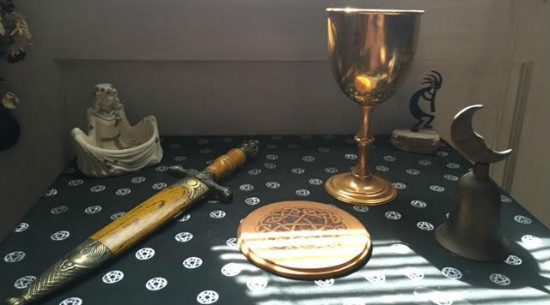
ADVANCED ALTARS
As a practice grows, our tools tend to grow right alongside of it. Eventually “the simple altar” items you’ve collected will share their space with a wide variety of working tools. For most Wiccan-Witches the most important tool is the athame, but anything that can be done with an athame can also be done with a wand or a finger. Tools help us move energy more effectively, but they aren’t necessarily requirements, especially in personal practice. What follows are the more common tools found on most altars (and are listed in the order I acquired them!). I find all of them helpful.
Wand: My first tool was a wand that I made from a wooden dowel and painted grey. One of my wife’s first working tools was a wand too. They are easy to put together making them a popular first working tool, and they don’t even have to be “made.” A branch or stick just “as is” makes an effective wand.
Bell: How many people get to say their second working tool was a bell!?! I do! I never used it very much but it’s been on my altar for twenty years now. I think I purchased mine at Woodstock ’94.
Chalice: My first chalice was a cheap wine glass (still have it!) and was eventually replaced by a gorgeous ceramic cup that looks to me like the very definition of a chalice.
Pentacle: A friend of mine gave me my first pentacle. It was a simple wooden disc, about the size of a drink coaster, with a pentagram burned onto it. It still sits in our ritual room.
Dish/Cauldron: One of my college roommates gave me an old sterling-silver bowl he got form his grandmother and I used it on my altar for many years to represent the element of water. (I really need to dig it up and put it to use again.)
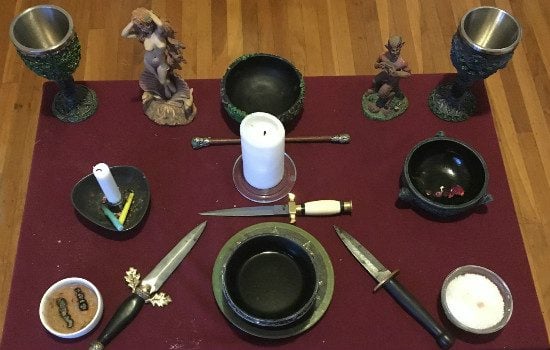
Athame: An athame doesn’t have to be elaborate, and a pocket-knife or even a butter knife will get the job done. The athame was one of the last working tools I acquired and was a gift from a friend. (With the exception of my wand and bell, all of my early working tools were gifts!)
Statues: Eventually I replaced the candles and posters I used to represent deity with a variety of statues. My first statue was either Cernunnos or Dionysus. I’ve got so many it’s hard to remember. My first goddess statue was one of Brigit.
Sword: Most of us don’t really need a sword, but they are cool to have. I got mine for Christmas one year.
Broom: My wife and I share a broom, we picked it up at a arts and craft fair, which are great places to find working tools.
Kerfain (White Handled Knife): We Witches like our pointy things! Many traditions don’t use the white handled knife all that much, especially if they use their athames for physical cutting. I try not to use my primary athame for physical cutting so I have a kerfain. Along with my boline they were the last (primary) working tools I got ahold of.
When buying ritual tools, slow and steady wins the race. Don’t buy anything that doesn’t feel “right” in your hands, and if you have to haggle over the price of it just walk away. If it’s meant to be, it will find it’s way to you (along with the money you may need for it). The best altar items and the best tools are the ones that are the best fit for the individual Witch.



